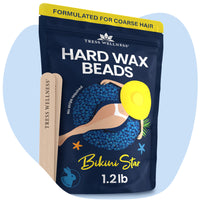Need a quick fix for prominent nose hair? This no-nonsense guide covers safe and efficient ways to banish unwanted hair, whether you’re at home or considering professional options. Learn how to get rid of nose hair through our practical tips and make those pesky strands a thing of the past.
Key Takeaways
-
Trimming nose hair is preferred over complete removal for maintaining respiratory health by filtering out dust and allergens, while still managing appearance.
-
For safe and effective at-home nose waxing, follow the proper preparation, application, and removal process with a kit like Tress Wellness and always perform a patch test first.
-
After waxing, use cool compresses, aloe vera, and avoid perfumed products to soothe sensitive skin and minimize irritation/infection risks; explore alternatives like trimming or laser removal for different needs.
Understanding Nose Hair and Its Functions

Nose hair is more than just a beauty concern. It’s a critical player in our respiratory health, serving as a frontline defense mechanism by trapping dust, allergens, and other microscopic particles. People with sparser nose hair, or those who strive to keep their nostrils hair free, often have a higher incidence of conditions like asthma due to less effective filtering of allergens and irritants.
Nose hair works in tandem with cilia to move mucus and trapped particles away from the lungs, keeping your respiratory system healthy. But it doesn’t mean you should let it grow wild. Trimming, rather than completely removing nose hair, is advised to maintain the nose’s ability to filter and protect against irritation and infection while managing visible hairs for aesthetic purposes.
A Step-by-Step Guide to Nose Waxing at Home

Now that you know the why, let’s get to the how. Nose waxing might sound daunting, but with our Tress Wellness nose wax kit, it becomes easier.
Preparing Your Tress Wellness Waxing Kit
Before we get started, let’s get the wax ready. The Tress Wellness waxing kit includes a professional-grade wax warmer with an LED indicator and temperature-adjusting dial for even heating. Depending on the type of wax you’re using, you’ll need to heat it to the right temperature for optimal use.
We recommend the following steps to achieve the desired honey-like consistency:
-
Set the temperature of the wax warmer between 150-170°F.
-
Turn the wax warmer to the maximum setting.
-
Cover the wax warmer with the lid until the wax reaches the right texture.
Application Process
The key to a successful waxing session is in the application.
-
Use a small waxing stick to scoop and swirl the wax until it's wrapped around the stick.
-
Gently insert the stick with the wax into your nose.
-
Allow the wax to cool down slightly and harden, but not completely, for easier removal of the wax along with the hair.
The Perfect Pull
Now, the moment of truth - the pull. To achieve a perfect pull, follow these steps:
-
Wait for the wax to be firm for a few seconds.
-
Pinch the bridge of your nose and hold it.
-
Then quickly remove the spatula from your nose in one swift motion.
Voila! You’ve just used nad’s nose wax to wax your nose hair at home.
Safety First: What to Avoid When Waxing Nose Hair
Like any beauty procedure, nose waxing comes with its own do’s and don’ts. Here are some tips to keep in mind:
-
Avoid overzealous removal of nose hairs, as it can lead to ingrown hairs.
-
Be cautious to prevent infections like nasal vestibulitis.
-
Nose waxing can potentially cause serious conditions such as nasal furunculosis.
To avoid introducing germs deeper into the nasal cavity, it’s important to be careful not to over-insert the wax applicator into the nose. Be mindful of the mucous membranes within the nasal cavity, which can be damaged by improper waxing techniques, increasing the risk of burns and inhalation of toxic fumes. Nose waxing carries certain risks, so to ensure safety, always heat nad’s nose wax according to the instructions provided.
Finally, remember that timing is everything. Schedule waxing appointments every four to six weeks to match your hair’s natural growth cycle, minimizing irritation and the chances of infection. And always perform a patch test prior to full application, especially if you are using skin thinning medication or have pre-existing skin conditions.
Alternative Nose Hair Removal Methods
While waxing is a convenient and effective method for nose hair removal, there are other options available. Trimming nose hair with special scissors or electric trimmers is the safest method, as it minimizes the risk of skin damage and over-trimming while managing visibility of hair. Nose wax, although effective, should be used with caution to avoid potential irritation or injury.
For those who prefer the hands-on approach to removing unwanted hair, nose hair plucking with blunt-ended tweezers can be used to remove nose hairs. However, this method may cause temporary irritation or inflammation of the skin, which could potentially lead to a cold or runny nose, especially when dealing with unwanted hair in the nasal area.
For a more permanent solution, laser hair removal offers a reduction in nose hair when conducted by a trained professional following a thorough consultation.
Post-Wax Care and Managing Sensitive Skin

After waxing, your skin might need a little TLC. To immediately reduce irritation and sensitivity, apply a cool compress or take a cool shower, and soothe the skin with lotions like aloe vera or aloe-based serums.
To prevent and reduce the risk of ingrown hairs and hyperpigmentation, you can:
-
Use gels with tea tree oil
-
Use products like the after-wax spray from Tress Wellness
-
Apply sunscreen
-
Treat any injuries with protective ointments or cool compresses
These measures can help maintain healthy skin and minimize the occurrence of ingrown hairs and hyperpigmentation.
Lastly, here are some recommendations to follow after waxing:
-
Avoid perfumed products
-
Engage in gentle physical activity
-
Use petroleum jelly orpre- and post-waxing sprays to protect and calm the skin
-
If adverse reactions such as minor allergic responses or infections occur, apply a cool compress, anti-itch lotion, or natural antiseptics
-
Consult a doctor for more serious symptoms
The Advantages of Choosing Tress Wellness for Nose Hair Removal
Choosing Tress Wellness for your nose hair removal needs comes with its own perks. Our nose hair waxing kit is designed with the specific needs of home-waxers ensuring ease of use for those new to at-home hair removal.
The all-in-one Tress Wellness waxing kit, suitable for all hair and skin types, offers aloe-enriched wax, providing a soothing experience that caters to a broad market.
But don’t just take our word for it. With over 30,000 glowing reviews, Tress Wellness showcases a trusted level of customer satisfaction that potential buyers can rely on.
Summary
In conclusion, nose hair removal is a delicate balance between maintaining health and aesthetics. With Tress Wellness, you can easily achieve this balance right at home. From understanding the functions of nose hair to mastering the art of waxing, we’ve got you covered. So, why wait? Empower your beauty routine and embrace the Tress Wellness difference today.
Frequently Asked Questions
How can I remove my nose hair?
You can remove your nose hair by trimming it or waxing. Trimming is a cost-effective method, but it requires regular maintenance, while waxing will give you smoother and longer-lasting results.
Does plucked nose hair grow back?
Yes, plucked nose hair does grow back over time, unless you've had multiple waxing sessions that can reduce their growth.
Why do I have so much hair inside my nose?
Your nose has a lot of hair to help block dust and allergens from entering your nasal cavity. The hairs and mucus layer work together to catch foreign particles.
What is the safest way to trim nose hair?
The safest way to trim nose hair is by using small cuticle or embroidery scissors to cut any hairs protruding from the nostril. It's important to be cautious while doing this to avoid injury.
What is the purpose of nose hair?
The purpose of nose hair is to act as a first-line defense mechanism, trapping dust, allergens, and small particles to prevent them from reaching the lungs. This helps protect the respiratory system from potential harm.




